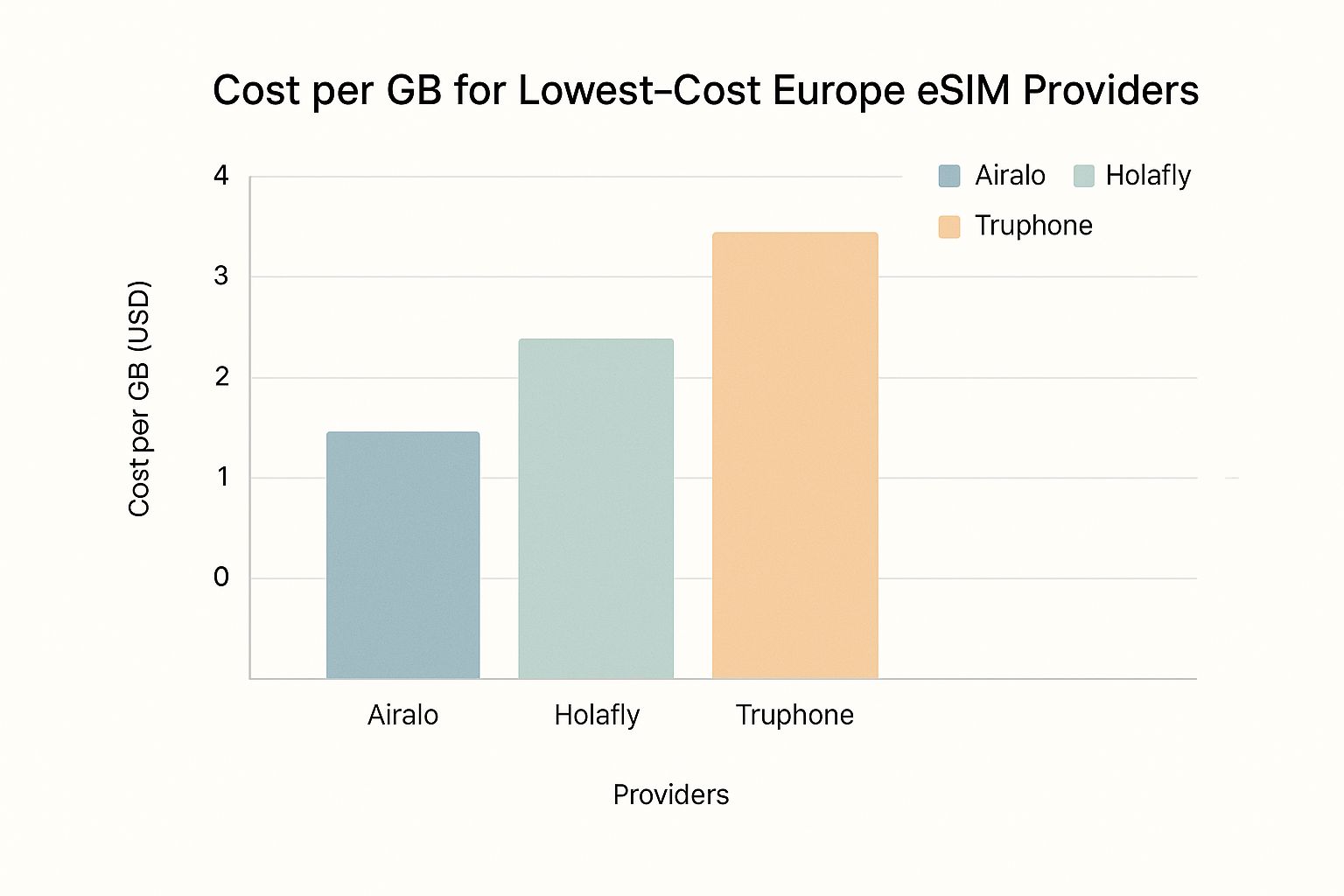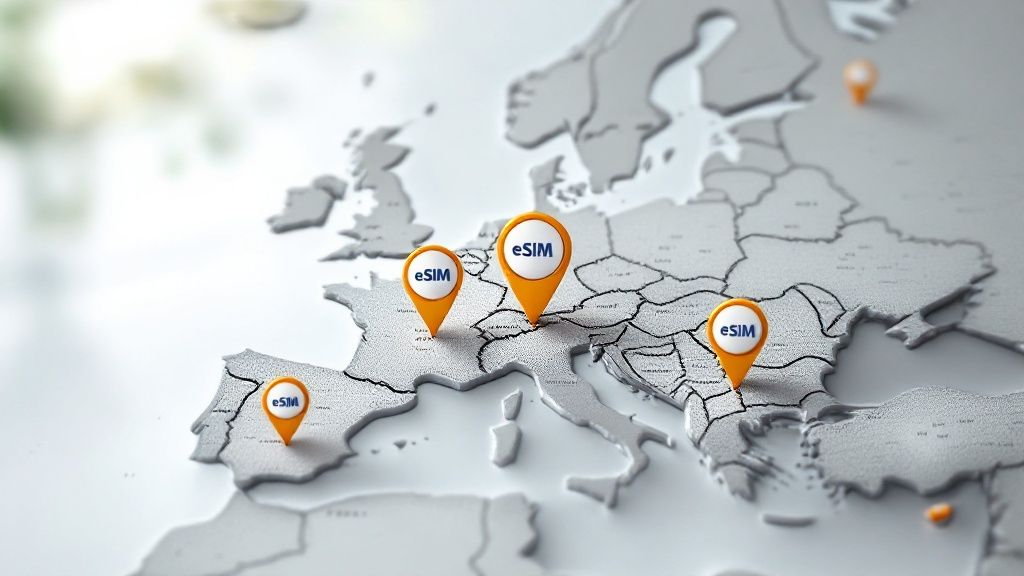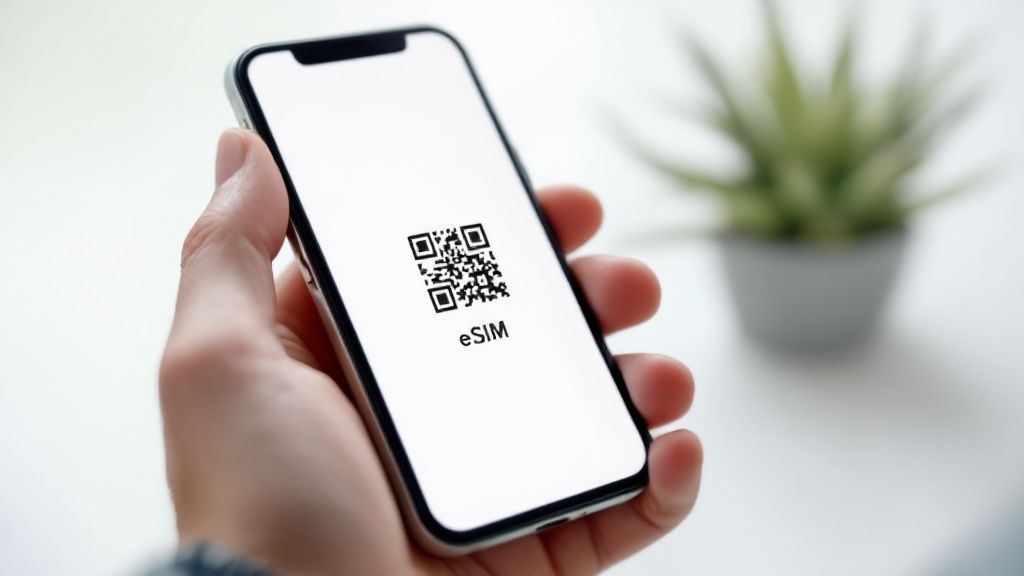When you're hunting for the cheapest Europe eSIM, it's easy to get fixated on the lowest upfront price. But the real bargain is found in the cost-per-gigabyte. Providers like Airalo might catch your eye with plans starting from just a few dollars, but the true value really hinges on your data habits and the length of your trip.
Finding the Best Value Europe eSIM

An eSIM, or embedded SIM, is a digital version of the physical SIM card you're used to. It lets you activate a mobile data plan without fumbling with tiny bits of plastic. For travellers, this is a game-changer. You can buy and install a data plan for Europe straight from your phone, getting you connected the second your plane touches down and letting you sidestep those notoriously high international roaming fees from your Aussie provider.
But the quest for the "cheapest" option goes beyond the sticker price. A genuinely cost-effective eSIM plan comes down to a few key factors that are much more important than the initial cost.
Key Factors Determining eSIM Value
To really find the best deal, you need to dig a little deeper. A cheap plan with minimal data or a short expiry can easily end up costing you more when you're forced to buy top-ups halfway through your holiday.
Here's what to look at:
- Data Validity: How long is the plan active for? If you're travelling for two weeks, a 30-day plan is far better value than a 7-day one, even if it costs a bit more to begin with.
- Country Coverage: Does the eSIM have you covered across all the countries on your itinerary? A single regional Europe eSIM saves you the headache and cost of juggling multiple plans.
- Cost Per Gigabyte (GB): This is the magic number. Simply divide the total price by the number of gigabytes included to find the true cost of the data you're buying.
The ultimate goal is to find an eSIM that provides sufficient data for your entire trip across all necessary countries at the lowest possible cost per GB, without hidden fees or restrictive policies.
For instance, Airalo offers European plans that cover 42 countries, with data-only options starting at just a few dollars for 1 GB valid for 7 days. This kind of flexibility is great for travellers who need a straightforward, affordable solution without buying a local SIM in every country, and it sets a good benchmark for what Aussies can expect.
By keeping these elements in mind, you can make a much smarter choice. To learn more about how to stay connected while you're travelling through Europe, you might find our dedicated guide on using a Europe eSIM helpful.
A Head-to-Head Comparison of Budget Europe eSIMs
Finding the cheapest Europe eSIM means you've got to look beyond the flashy headline prices and dig into the details that actually matter on the road. Let's break down how the leading budget-friendly providers like Airalo, Holafly, and Nomad really stack up against each other. We’ll go past simple feature lists to analyse the practical value each one offers for your trip.
A raw comparison of providers often kicks off with cost per gigabyte, a critical number for any traveller keeping an eye on their budget.
This chart shows the average cost per gigabyte among some of the top budget-friendly eSIM providers for Europe.

As you can see, some providers clearly have an edge when it comes to the raw cost of data, making them an immediate frontrunner if value is your main goal.
Airalo: The All-Rounder
Airalo is a name you'll hear a lot, and for good reason. It's a top pick for travellers looking for that sweet spot between affordability and wide coverage. Their plans cover over 40 European countries, which makes them a fantastic choice for multi-country trips.
Their pricing is seriously competitive, particularly for smaller data packages. For a week-long getaway, you can often grab a suitable plan for under $10, putting it among the most accessible options out there. It’s all very straightforward. Just know that most of their plans are data-only, so you’ll be using apps like WhatsApp or Messenger for calls.
The real strength of Airalo is its sheer simplicity and reliability. For most people hopping between several countries, their regional plans are a genuine "set it and forget it" solution with consistent connectivity.
To see how it compares directly with other big names, check out our in-depth analysis of SimCorner vs Airalo eSIMs for a detailed feature breakdown.
Holafly: The Unlimited Data Specialist
Holafly has carved out a specific niche for itself by offering unlimited data plans. This is a huge drawcard for heavy data users—think streamers, remote workers, or anyone who relies heavily on maps. The peace of mind that comes with not having to track every single megabyte is a major plus.
But, that word "unlimited" usually comes with a catch: a fair use policy. After you burn through a certain amount of high-speed data each day (often 3-5GB), your speeds can be throttled right down.
Another critical thing to watch for is hotspot tethering. Many of Holafly’s unlimited plans either block or severely cap your ability to share data with other devices, like a laptop. If you're planning on working from a café, this could be an absolute deal-breaker.
Nomad: The Flexible Contender
Nomad is another strong competitor in the race for the cheapest Europe eSIM, often getting praise for its user-friendly app and competitive prices. It offers both country-specific and regional plans, giving you a bit more flexibility depending on your itinerary.
Much like Airalo, most of Nomad’s plans are data-only, so it's best for travellers who are comfortable using internet-based apps to communicate. The main differences between Nomad and its rivals often boil down to specific promotions and which local networks they partner with, which can sometimes mean better speeds in certain countries.
Europe eSIM Provider Cost and Feature Breakdown
To make things a bit clearer, here’s a simplified table comparing these popular budget options side-by-side. It’s designed to help you quickly see which provider might be the best fit for your travel style.
| Provider | Starting Price | Average Cost per GB | Countries Covered | Key Feature or Limitation |
|---|---|---|---|---|
| Airalo | ~$5 AUD | ~$2-$3 AUD | 40+ | Great for multi-country trips on a budget. |
| Holafly | ~$30 AUD | Varies (Unlimited) | 30+ | "Unlimited" data is ideal for heavy users. |
| Nomad | ~$6 AUD | ~$3-$4 AUD | 35+ | Easy-to-use app with flexible plan options. |
When it comes down to it, the best choice really depends on what you need. If your number one priority is the absolute lowest cost for basic data across a bunch of countries, Airalo is often the winner. But if you need heaps of data and can live with potential hotspot limits, Holafly's unlimited plans are pretty compelling.
Calculating the True Cost Per Gigabyte

When you're on the hunt for the cheapest Europe eSIM, there's one number that matters more than any other: the cost per gigabyte (GB). It’s easy to get drawn in by a low headline price, but that can often disguise a terrible deal if the data allowance is tiny. Figuring out this simple metric lets you see past the flashy marketing and find a plan that’s genuinely good value.
The maths is straightforward: just divide the total price of the plan by the amount of data you get. For instance, a $20 plan that comes with 10 GB of data works out to $2 per GB. A plan that looks cheaper at $10 but only gives you 2 GB of data is actually $5 per GB — more than double the price for the data you’ll be using.
This one calculation is your best friend for comparing different providers and plans on a level playing field. It cuts through the noise and shows you where the real value is.
Why Larger Data Bundles Offer Better Value
Once you start comparing a few plans, you'll spot a pattern pretty quickly. Larger data packages almost always have a lower cost per gigabyte. It makes sense – providers want to lock you in for a bigger purchase, and they reward you with better rates for doing so.
Let's look at a couple of common scenarios:
- Plan A (Short Trip): A traveller grabs a 5 GB plan for $15, which comes to $3 per GB. That’s probably fine for a quick city break.
- Plan B (Longer Trip): Another traveller plans ahead and gets a 20 GB plan for $40. Their cost plummets to just $2 per GB.
If you're planning a multi-week trip across Europe, committing to a larger data bundle from the get-go is one of the smartest ways to keep your costs down. It saves you from having to do those expensive, frantic top-ups later, which always come with a much higher per-gigabyte rate.
By focusing on the cost per GB, you shift from simply finding a cheap plan to securing the best value. This ensures you have enough data for your entire trip without overpaying for small, inefficient packages.
Factoring in the Validity Period
Of course, the cost per gigabyte doesn't tell the whole story. You also need to eyeball the plan's validity period. The best eSIM for your trip has to give you enough data for the entire duration. A high-data plan with a rock-bottom price is useless if it expires halfway through your holiday.
Imagine finding a 30 GB plan valid for only 15 days. Even if the cost per GB is amazing, it's a poor choice for a month-long adventure. You'd be forced to buy a second plan, instantly doubling your cost. Always make sure the plan’s validity lines up with your itinerary to avoid this common trap. You want your data to last from the day you land to the day you fly home.
Matching an eSIM Plan to Your Travel Style

Let's be honest, the idea of a single "cheapest Europe eSIM" is a bit of a myth. What's cheap for one person can be a total waste of money for another. The real value isn't found in the lowest price tag, but in the plan that gives you exactly what you need without a single megabyte or feature going to waste.
Thinking about your travel style is the first and most important step. A quick weekend getaway has completely different data demands than a month-long digital nomad stint. By figuring out which type of traveller you are, you can sidestep the classic traps: either paying for a massive data plan you'll never use or, even worse, getting stung with expensive top-ups because you underestimated your needs.
The Short-Stay Traveller
Off to Europe for a long weekend or a quick city break? Your goal is simple, cheap connectivity. You just need enough data for the essentials – navigating with Google Maps, checking train times, and maybe posting a few stories to Instagram. A huge data allowance or a 30-day validity period is just overkill.
For this kind of trip, a small, short-term data plan is easily your most wallet-friendly option.
- Ideal Plan Type: Look for something with 1-3 GB of data that's valid for 7 days. This is usually the sweet spot.
- Why It Works: You're only paying for what you'll realistically use on essential travel apps. It stops you from throwing money away on a bigger, 30-day plan where most of the data and time would expire unused.
- Provider Suggestion: Check out providers like Airalo or Saily. They often have small, budget-friendly packages that are perfect for these short hops.
The Multi-Country Backpacker
If you're embarking on a classic European backpacking trip—bouncing between countries every few days for a month or more—your priorities shift dramatically. You need broad, hassle-free coverage across dozens of countries and a data plan that will see you through the whole trip without needing constant attention.
The single biggest mistake a backpacker can make is buying a new eSIM for every country. A regional Europe plan is almost always cheaper and infinitely more convenient. It saves you the headache of switching plans every time you cross a border.
Your perfect plan is a careful balance of coverage, data, and validity.
- Ideal Plan Type: A regional Europe plan with 10-20 GB of data valid for at least 30 days.
- Why It Works: This gives you one single plan that just works, whether you're in Paris or Prague. The generous data pool gives you peace of mind for a full month of travel, covering everything from booking hostels on the fly to video-calling home.
- Provider Suggestion: Regional plans from Airalo or Nomad usually hit that sweet spot of wide coverage and a competitive cost-per-gigabyte for longer journeys.
The Digital Nomad or Heavy User
Working from your laptop in a European café or just someone who loves to stream video and share your connection? Your needs are in a different league entirely. The priority here is a massive bucket of reliable data and, most importantly, generous hotspot tethering.
"Unlimited" plans can sound like the perfect solution, but you have to read the fine print. Many of these come with a sneaky fair use policy that can throttle your speeds after you hit a certain daily limit or, worse, severely restrict how much data you can share via a hotspot. For a digital nomad, a throttled connection is a complete deal-breaker.
- Ideal Plan Type: A huge data bundle (50 GB or more) or a true unlimited plan with very clear, generous hotspot allowances.
- Why It Works: This setup ensures you've got all the bandwidth you need for video calls, uploading large files, and personal browsing without constantly worrying about hitting a data cap.
- Provider Suggestion: While Holafly is well-known for its unlimited data plans, you absolutely must check its latest hotspot limitations before buying. Sometimes, simply grabbing the largest data bundle from another provider can give you more predictable high-speed data for tethering.
That great deal you spotted on a Europe eSIM might not be as cheap as it looks. The headline price can be a real trap for travellers, with hidden fees and extra costs buried in the fine print turning a bargain into a budget-breaker.
The usual suspects are taxes and service fees that magically appear at the final checkout, instantly inflating the price. Some providers also tack on a one-time activation fee that wasn’t mentioned on the product page. These little extras can easily make a supposedly cheaper plan more expensive than its rivals.
Scrutinising the Terms Before You Buy
Before you hit 'buy' on any eSIM, you need to do a little detective work. Spending a few minutes digging into the terms and conditions can save you a world of pain and money later on. Any provider worth their salt will make this information clear and easy to find.
Here’s a quick checklist of what to look for:
- Top-Up Rates: If you run out of data, what’s it going to cost to add more? Some companies lure you in with a cheap initial plan but charge an arm and a leg for top-ups, knowing you’ll be desperate for more data mid-trip.
- Fair Use Policies: For those "unlimited" plans, what’s the real high-speed data cap per day? Once you hit it, your connection speed is often throttled so much it becomes practically unusable. For a deeper dive, our guide explains what providers often don't tell you about unlimited data travel eSIMs.
- Tethering and Hotspot Rules: Can you share your data connection? Many unlimited plans put strict limits on personal hotspots or ban them completely, which is a major problem if you need to connect your laptop.
- Refund Policy: What’s the go if the eSIM doesn’t work or you can’t get it activated? Knowing the refund process gives you a bit of a safety net.
Always look beyond the headline price. A truly cheap Europe eSIM is one that offers transparent pricing from start to finish, with no surprise fees for activation, taxes, or essential features like hotspotting.
Smart Data Monitoring on the Go
The best way to sidestep the most expensive surprise—running out of data—is to keep a close eye on your usage. Your phone’s built-in settings are your best mate for this. Before you even switch on your eSIM, reset your mobile data stats. This gives you a clean slate to track exactly how much data your travel eSIM is chewing through.
Most provider apps have a data usage tracker, too. Get into the habit of checking it every day or two. This helps you catch heavy usage early and change your habits—like using Wi-Fi for big downloads—before you’re stuck buying a pricey top-up.
Our Final Say and How to Get Activated
We’ve dug into the costs, sized up the providers, and looked at how different plans fit various travel styles. Now, it's time to put it all together. The hunt for the cheapest Europe eSIM really boils down to your specific itinerary and how much data you actually use. So, instead of a one-size-fits-all answer, let's look at some final recommendations based on the travellers we see most often.
Think of these as a starting point to make sure you’re choosing a plan that gives you real value for your trip.
-
Best for Short Trips (Under 10 Days): For a weekend getaway or a quick city break, you can't go wrong with the smaller data packages from Airalo or Saily. A 1-3 GB plan with a 7-day validity is usually spot on for navigating and some light browsing, meaning you won't pay for data you never use.
-
Best for Multi-Country Backpackers (30+ Days): If you're country-hopping for a month or more, a regional Europe plan is an absolute must. Look for 10-20 GB plans from providers like Airalo or Nomad. They hit that sweet spot of wide coverage, plenty of data, and a really low cost-per-gigabyte.
-
Best for Heavy Data Users: Need a ton of data for streaming or getting work done? Holafly’s unlimited plans look tempting. Just be sure to double-check their hotspot tethering rules before buying, as they can sometimes be a bit restrictive. If you need guaranteed hotspot access, a big 50-100 GB data bundle from another provider might be the more reliable choice.
The perfect eSIM is one that matches your trip's length, covers every country you're visiting, and gives you just the right amount of data at the lowest possible price per GB. Overpaying for data you don't need is just as frustrating as running out halfway through your holiday.
A No-Fuss Guide to Activating Your eSIM
Once you've picked out the perfect plan, getting it up and running is pretty straightforward. While the exact buttons you press might look a little different in each provider's app, the basic process is the same no matter who you go with. This guide will walk you through it.
Follow these steps before you leave home for a smooth setup.
-
Check Your Phone is Ready: First things first, make sure your smartphone is unlocked and eSIM-compatible. Most phones from the last few years are, but a quick look in your settings or an online search will confirm it for you.
-
Buy Your Plan: Choose your provider and purchase the Europe eSIM plan that fits your travel needs. You’ll get an email confirmation, which will have a QR code or manual activation details inside.
-
Install the eSIM: The easiest way to do this is by scanning the QR code they send you. On your phone, head to Settings > Mobile Data > Add eSIM (or similar wording) and use your camera to scan the code. It's best to do this while you're still at home and connected to Wi-Fi.
-
Activate When You Land: Your plan's validity period usually kicks in the moment it connects to a network in Europe. Once you land, just pop back into your mobile data settings, switch on your new eSIM line, and make sure you enable data roaming for it. Your phone should connect to a local network within a few minutes.
By following this process, you can land in Europe and feel confident knowing your data connection is ready to go the second you turn off flight mode.
Ready to travel with seamless, affordable data? At SimCorner, we provide reliable and cost-effective eSIMs for Europe and destinations worldwide. Find the perfect plan for your adventure today.
https://simcorner.com



